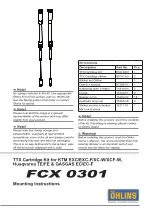
72
000000Ć1150Ć839 IOLMaster 11.02.2004
If the instrument has been properly aligned, the images of the fixation
point and the front surface of the crystalline lens will be sharp at the
same time, as they are approximately in the same plane.
As a rule, the image of the fixation point lies between the image of the
anterior lens and that of the cornea if the instrument is optimally
aligned.
Note:
The image of the fixation point must not be placed in the image of
the lens or cornea!
Fig. 63 Optimally adjusted optical section (lens with cataract)
Fig. 62 and Fig. 63 show optical sections of right eyes.
The patterns left of the corneal image are direct reflections of the
luminous light exit aperture of the lateral slit projector. These reflections
are not needed for the calculation of the anterior chamber depth. They
must
not
affect the image of the cornea (see below).
At the left margin of the picture, additionally reflections are visible
produced by the ambience (here, a window) being in front of the
patient. Depending on the lighting conditions in the examination room
it may also be possible that you see the front side of the IOLMaster
produced by the cornea. These artifacts do not disturb the measureĆ
ment of anterior chamber depth unless the significant image details
(images of cornea and crystalline lens) as well as the image of the
fixation point are significantly weaker than some kind of extraneous
light. This may be alleviated by slightly darkening the examination room.
If the above requirements are not met the results will be either erroĆ
neous or not possible. Because of the complexity of the images measuĆ
red it might be possible that erroneous measurements are not recogniĆ
zed as such under certain circumstances.
The IOLMaster must be adjusted very carefully for anterior chamber
depth measurements.
Tips for
anterior chamber depth measurement
















































